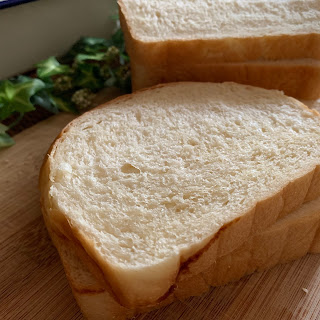A similar sweet bread as my previous Traditional Sweet Bread I , but using overnight cold fermentation and a little adjustment to the original recipe. The result was a better moisture content and texture bread ✌👍😋
Yield: 2 loaves in a pan
Pan size: Wiltshire enamel coated pan 21x13x6cm
Raw dough weight: 593g
Baking temperature: Preheated oven to 190℃, bake at middle rack at 180℃ for 13 minutes, 170℃ for about 12 minutes, off for 3 minutes. Tent at 10th minute.
Water Roux
3g bread flour
2g glutinous rice flour
25g water
1. Mix and stir over low heat till it thicken into a glossy paste.
2. Cool down and collect about 25g for use later.
Cover with an inverted glass till needed.
Sweet Bread Dough
Ingredients210g bread flour
80g Prima plain flour plus/plain flour
40g raw cane sugar
1g instant dry yeast
3g low-sodium fine salt
25g water roux from above
20g beaten egg
30g natural yeast*
20g condensed milk
130g fresh milk, cold
10g cold water, added depending on dough condition
30g unsalted butter, added after gluten formed
Toppings
egg wash
* 30g of natural yeast can be replaced by 15g each of bread flour and water. You can add 1/8 tsp of instant dry yeast if you want to have a shorter proofing period.
Directions
1. Mix all the dry ingredients in the mixing bowl of a stand mixer.
2. Add all the wet ingredients, except the 10g of water and unsalted butter, into the mixing bowl.
 |
| wet ingredients |
 |
| natural yeast |
 |
| water roux |
 |
| cold milk |
 |
| Keep the dough in the vegetable drawer for about 20 minutes |
3. Knead the dough at low speed till it forms into a smoother dough.
Add the 10g of water depending on the dough moisture.
 |
| End of kneading |
 |
| Give the dough about 50 sets of slap and fold into a smooth dough |
4. Keep the dough in double plastic bags and in a covered container, before keeping in the fridge to undergo about 16 to 18 hours of cold fermentation.
5. Invert the dough onto a floured worktop. Deflate and divide into two portions.
Shape the dough into two balls, cover and let them rest for 15 minutes.
6. Take a dough and flatten it slightly, and shape into a round dough again.
Lower the shaped dough into the bread pan coated with a thin layer of butter. Spray some water, cover with a tea cloth, and let them proof for about 90 minutes, or till reaching the rim of the pan.
End of 90-minute second proofing
7. Preheat the oven to 190℃. While waiting, brush a coat of egg wash over the top.
Bake at middle rack of an oven preheated to 190℃, lower temperature to 180℃ for 13 minutes, further lower to 170℃ for 12 minutes, turn off the oven and bake for 3 minutes, or till the top has become golden. Tent the top with aluminum foil at about 10th minute into baking to prevent over-browning the top.
8. Transfer the bread out of oven, and remove from pan immediately.
9. Let the bread rest on a wire rack.












































No comments:
Post a Comment
I love seeing your comment and sharing it with other readers. Your comment would be published after moderation. Thank you :)